 | We learn about........ | |
We have so far learned in this module……
The goal of this lesson is to learn …..
Let us first watch the later part of Classroom Sambashanam Video and familiarize ourselves with some more sentences commonly used in day to day conversations.
| Conversation Practice - सम्भाषणाभ्यासः | |
|---|---|
| कदा – When? | |
| कदा उत्तिष्ठति? | पञ्चवादने उत्तिष्ठामि। |
| कदा अल्पाहारं करोति? | सार्ध-अष्टवादने अल्पाहारं करोमि। |
| कदा विद्यालयं गच्छति? | नववादने विद्यालयं गच्छामि। |
| कदा योगाभ्यासं करोति? | सार्ध-चतुर्वादने योगाभ्यासं करोमि। |
| सत्यं वा? | अहो! |
| दिनचरी – Daily routine | कदाश्चित् - Sometimes |
| भोः | एवम् वा? |
| फलं कुत्र अस्ति? | फलं स्थालिकायाम् अस्ति। |
| शृतस्य सुभाषितस्य अर्थः एवम् अस्ति। | |
Look at the Traffic Signal Pictures.
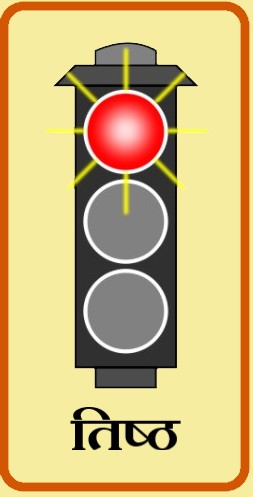 | 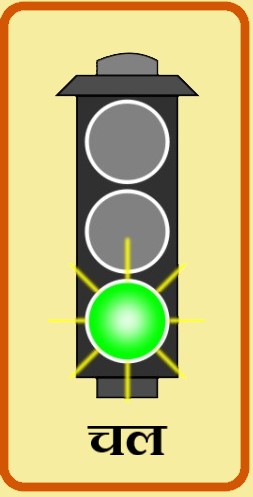 |
Red signal is understood in Sanskrit as ‘तिष्ठ' and the Green as ‘चल’. Both words indicate the sense of an Order or a request.
Let us look at some common conversation scenarios.
| माता पुत्रं प्रति वदति……….. | उत्तिष्ठ – Wake up/Get up अल्पाहारं खाद – Have Breakfast दुग्धं पिब – Drink Milk विद्यालयं गच्छ – Go to School |
| अध्यापकः वदति………. | राम आगच्छ – Rama, Come. पाठं पठ – Read the lesson कृष्णपलकं पश्यन्तु – Look at the Board (All) सर्वे उपविशन्तु – You may all sit. |
The verb forms highlighted on the right side are different from लट् the standard present tense forms we are familiar with. These forms give the sense of Order/Request (आज्ञा/प्रार्थना) are technically know as ‘लोट्’. लोट्-क्रियारूपाणी are Samskrit equivalents for usage with auxiliary verb ‘May’ and sentences with ‘Let’ in English.
Just as लट् (Present tense) लोट् (Imperative) also has 9 different forms for each verb root that align with पुरषः (Person) and वचनम् (Number). In this lesson we will be learning both common and special लोट् forms for the verb roots that were introduced in earlier lessons. We restrict our learning to लोट् forms of Parasmeipadi Dhatus to make the learning process easier. We propose to introduce Atmanepadi forms in the next module, and the learner’s knowledge on Kriyapadani will be further enriched.
We learn the लोट् forms separately for each person (पुरुषः). The table below shows the third person (प्रथमपुरुषः) endings added to धातुः to bring in the imperative (लोट्)mood. It is followed by the pictorial explanation of the conjugation process.
| लोट्-परस्मैपदान्ताः – Imperative Endings | |||
|---|---|---|---|
| एकवचनम् | द्विवचनम् | बहुवचनम् | |
| प्रथमपुरुषः | तु | ताम् | अन्तु |
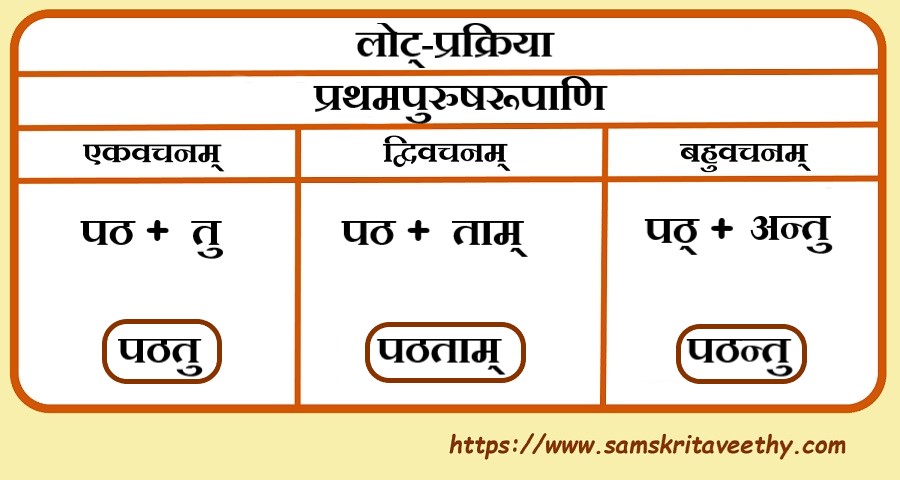
Let us now look at some लोट्-क्रियापदानि for प्रथमपुरुषः where Special verbs (विशेषक्रियारूपाणि) also follow the similar conjugation rules.
| लोट्-प्रथमपुरुषरूपाणि | |||
|---|---|---|---|
| धातुः | एकवचनम् | द्विवचनम् | बहुवचनम् |
| पठ् | पठतु | पठताम् | पठन्तु |
| गम् | गच्छतु | गच्छताम् | गच्छन्तु |
| लिख् | लिखतु | लिखताम् | लिखन्तु |
| अस् | अस्तु | स्ताम् | सन्तु |
| भव् | भवतु | भवताम् | भवन्तु |
| क्री | क्रीणातु | क्रीणीताम् | क्रीणन्तु |
| कृ | करोतु | कुरुताम् | कुर्वन्तु |
| ज्ञा | जानातु | जानीताम् | जानन्तु |
| श्रु | शृणोतु | शृणुताम् | शृण्वन्तु |
We have few example sentences using लोट् form in प्रथमपुरुषः.
| लोट्-उदाहरणानि - प्रथमपुरुषः | |
|---|---|
| भवान् पश्यतु। | You (masculine) may please see. |
| रामः गृहं गच्छतु। | Let Rama go home. |
| भ्रातरौ पितरम् अनुसरताम्। | Let the brothers follow the father. |
| युवत्यः गीतं गायन्तु। | Let the young women sing. |
| भवती अन्नं पचतु। | May you (female) cook food. |
| सः अत्र तिष्ठतु। | Let him stay there. |
| पुत्र्यौ गृहकार्यं कुरुताम्। | Let the daughters do household work. |
Imperative verb forms occur more commonly in second person than in other persons. We now learn लोट् endings added to धातुः for मध्यमपुरुषः. Picture that follows explains the Conjugation process (प्रक्रिया) for second person.
| लोट्-परस्मैपदान्ताः – Imperative Endings | |||
|---|---|---|---|
| एकवचनम् | द्विवचनम् | बहुवचनम् | |
| मध्यमपुरुषः | - | तम् | त |
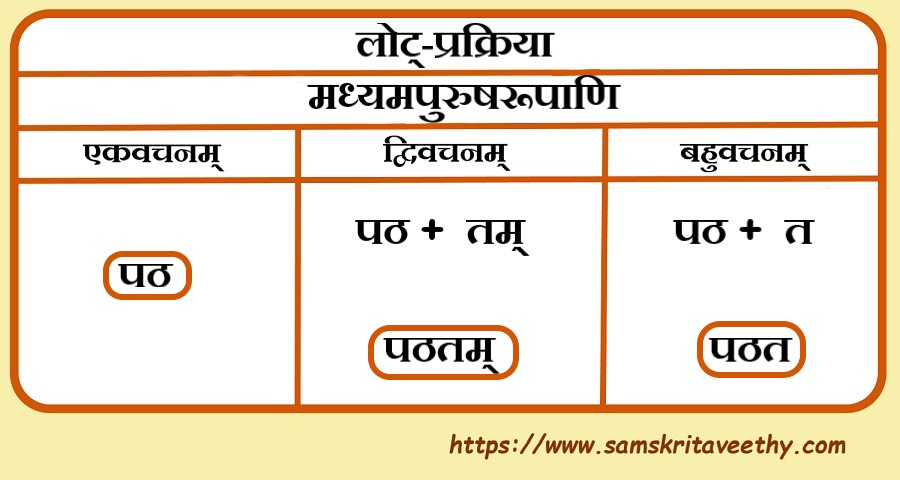
Second person लोट् forms for special verbs vary slightly in एकवचनम्. We have placed similar forms close to each other in the table.
| लोट्-मध्यमपुरुषरूपाणि | |||
|---|---|---|---|
| धातुः | एकवचनम् | द्विवचनम् | बहुवचनम् |
| पठ् | पठ | पठतम् | पठत |
| गम् | गच्छ | गच्छतम् | गच्छत |
| लिख् | लिख | लिखतम् | लिखत |
| भव् | भव | भवतम् | भवत |
| अस् | एधि | स्तम् | स्त |
| क्री | क्रीणीहि | क्रीणीतम् | क्रीणीत |
| ज्ञा | जानीहि | जानीतम् | जानीत |
| कृ | कुरु | कुरुतम् | कुरुत |
| श्रु | शृणु | शृणुतम् | शृणुत |
We also have some example sentences to bring in more clarity on लोट्-मध्यमपुरुषरूपाणि
| लोट्-उदाहरणानि - मध्यमपुरुषः | |
|---|---|
| त्वं पाठं पठ। | You read the lesson. |
| (त्वं) बहिः न गच्छ। | Do not go out. |
| युवाम् अल्पाहारं खादतम्। | You two may take refreshments. |
| यूयं गृहपाठं कुरुत। | May you all do the homework. |
| (त्वं) कीर्तिमान् भव। | Be famous! |
| युवाम् अवधानेन शृणुतम्। | May two of you listen carefully. |
| यूयं धर्मं चरत। | May you all follow Dharma. |
Let us now learn the imperative forms for first person (उत्तमपुरुषः). In first person लोट् forms indicate intention or a request. We first see the अन्ताः (Endings) for First person and then the pictorial explanation of प्रक्रिया.
| लोट्-परस्मैपदान्ताः – Imperative Endings | |||
|---|---|---|---|
| एकवचनम् | द्विवचनम् | बहुवचनम् | |
| उत्तमपुरुषः | आनि | आव | आम |
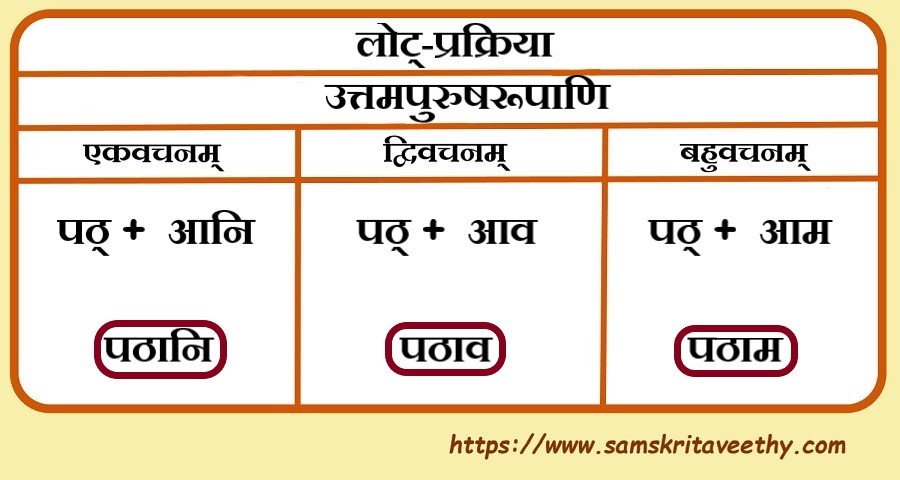
As we observed in मध्यमपुरुषः लोट् forms special verbs show a slightly different pattern in the लोट् forms of उत्तमपुरुषः as well. We have again placed similar forms close to each other.
| लोट्-उत्तमपुरुषरूपाणि | |||
|---|---|---|---|
| धातुः | एकवचनम् | द्विवचनम् | बहुवचनम् |
| पठ् | पठानि | पठाव | पठाम |
| गम् | गच्छानि | गच्छाव | गच्छाम |
| लिख् | लिखानि | लिखाव | लिखाम |
| भव् | भवानि | भवाव | भवाम |
| अस् | असानि | असाव | असाम |
| क्री | क्रीणानि | क्रीणाव | क्रिणाम |
| कृ | करवाणि | करवाव | करवाम |
| ज्ञा | जानानि | जानाव | जानाम |
| श्रु | शृणवानि | शृणवाव | शृणवाम |
Remember we heard the word पठाम in the Conversation video. We are now set to see some example sentences with लोट् First person forms.
| लोट्-उदाहरणानि - उत्तमपुरुषः | |
|---|---|
| अहं गच्छानि वा? | May I go? |
| वयं पाठं पठाम। | Let us read the lesson. |
| आवां विहारं करवाव। | Let us (we two) go around. |
| वयम् बुद्धिमन्तः भवाम। | Let us be wise. |
| अहं श्लोकं गायानि। | Let me sing the sloka. |
| आवां फलरसं पिबाव। | Let us (we two) drink Fruit juice. |
| वयम् स्नानं करवाम। | Let us take bath. |
| अहं दूरदर्शनं पश्यानि | Let me watch TV. |
| आवां पत्रक्रीडां क्रीडावः। | Let us (we two) play cards. |
Let us now present the complete table for Imperative endings in all three persons.
| लोट्-परस्मैपदान्ताः – Imperative Endings | |||
|---|---|---|---|
| एकवचनम् | द्विवचनम् | बहुवचनम् | |
| प्रथमपुरुषः | तु | ताम् | अन्तु |
| मध्यमपुरुषः | - | तम् | त |
| उत्तमपुरुषः | आनि | आव | आम |
You may be interested in learning the लोट् forms of some common verbs we are familiar with. Please click the verbs to view the complete लोट् table for the verb.
| पठ् | लिख् | गम् | खाद् | पा |
| दृ | दा | ज्ञा | क्री | आप् |
| श्रु | प्रच्छ् | स्था | पत् | ग्रह् |
| कृ | चि | शक् | रुद् | तॄ |
| नम् | कृष् | नृत् | रक्ष् | भ्रम् |
| वद् | अस् | हस् | कुप् |
We will get ourselves familiar with other Dhatus as we advance in learning. Lessons in the next module will focus on identifying the elements in Noun and Verb forms and make us conversant with their usages.
किञ्चित् अभ्यासं कुर्मः वा?
छात्राः गच्छन्ति। छात्राः __________.
लोटि परिवर्त्तनम्: छात्राः गच्छन्तु।
धावति
धावतु धावताम् धावन्तु
धाव धावतम् धावत
धावानि धावाव धावाम
अ) अर्चति (Prays) आ) स्मरति (Thinks/Remembers) इ) प्रविशति (Enters) उ) तोषयति (Praises) ऊ) निर्वापयति (Chooses/Elects)
We welcome your views and suggestions on this lesson. Please post your comments and replies after registering. Please also send a mail to samskrit@samskritaveethy.com for any clarification on the lesson.
We have so far learned....
Rama! Go to School.
In the above sentence we can feel the लोट् sense. What will happen to a name when we address a person? We learn in the next lesson we learn to form sentences using सम्बोधन-प्रथमा विभक्तिः combined with लोट्-क्रियापदम्. Our next lesson…
Lesson 10: Vocatice/Address Case in Sanskrit - संबोधन-प्रथमा विभक्तिः
 | 0 comments |
To get updates on
संस्कृतवीथी...